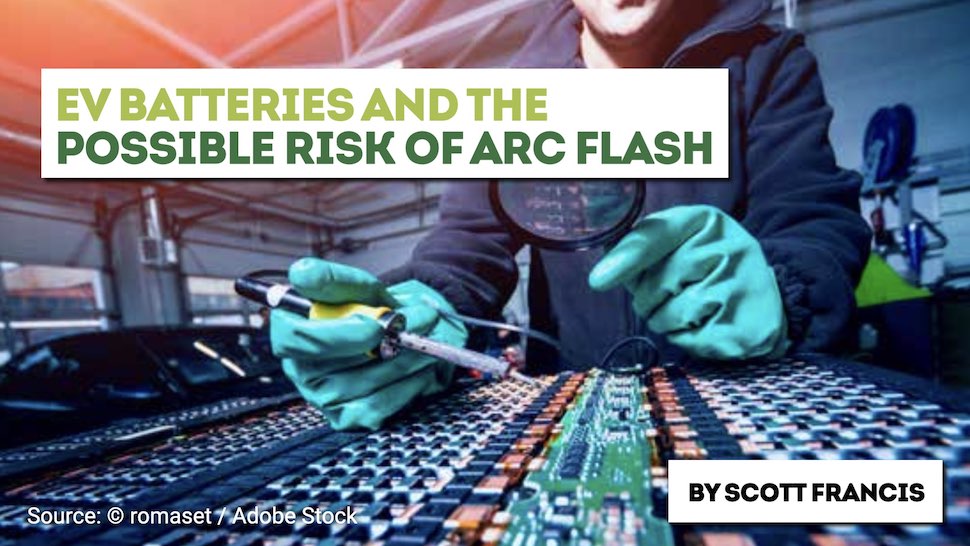
Articles
Cleantech
Electrified Transport
Features
Articles
Energy & Power
Energy Storage
Vehicles
EV batteries and the possible risk of arc flash
April 7, 2023 | By Scott Francis
High-voltage electric vehicle batteries present unique safety challenges

April 7, 2023 – Electric vehicles (EVs) are gaining in popularity as a sustainable alternative to gasoline-powered cars, and they’re quickly being seen as a key player in helping the governments achieve their near- and long-term environmental goals.
According to Transport Canada, reducing emissions from on-road vehicles is key to achieving Canada’s goal of net-zero emissions by 2050, which leads to investments in purchasing decisions, charging stations and regulations to support the sale of electric vehicles.
While the number of EVs on Canadian roads is still lower than in some other developing countries (just 168,000 of the 25 million registered vehicles in 2019 were EVs, according to Inside EVs), purchases of electric vehicles went up 30% in the first half of 2022—which indicates consumer purchasing behaviour could be shifting in the near future, and longer term.
One often-overlooked consideration in the conversation around EVs is how the high-voltage batteries they employ present unique safety challenges to the people who build and maintain these vehicles, particularly in the context of arc flash incidents.
Batteries and their cells
An arc flash is a dangerous electrical phenomenon that occurs when an electric current travels through the air between conductors instead of through the intended path. This can cause an electrical explosion and the release of a large amount of energy in the form of heat, light, sound, and pressure.
According to Oak Ridge National Laboratory, the heat generated by an arc flash can be intense, reaching temperatures as high as 35,000 C, which is hot enough to vaporize metal and cause serious burns.
The risks of arc flash are particularly significant when handling electric vehicle batteries, which can contain hundreds of volts of electricity. One of the main reasons for the increased risk is the use of high-voltage lithium-ion batteries, which are commonly used because to their high energy density and long life span.
Lithium-ion batteries are made up of a number of individual cells, each of which has its own low voltage but, collectively, provide enough voltage to propel a vehicle. The lithium-ion batteries in EVs have a number of these cells connected together. For example, according to engineering.com, a powerful EV like the Tesla Model S has 7104 battery cells!
At times, these batteries can produce voltages approaching 1000 VDC or more. DC voltages well above 100V and arc flash currents of thousands of amps indicate potential arc flash and shock hazards, as per CSA Z462 “Workplace electrical safety” and NFPA 70E “Standard for electrical safety in the workplace”.
Electrical complexity
Another factor contributing to the risk of arc flash in EVs is the complexity of the electrical systems used in these vehicles. Unlike their internal combustion engine (ICE) counterparts, EVs have multiple high-voltage components, including the battery pack, the electric motor, and the charging system—all areas that could present potential opportunities for arc flash incidents to occur when energized.
Approach with best practices
There are multiple ways a battery manufacturer or maintenance worker could be exposed to battery arc flash, including: when connecting cables into battery-fed systems; changing components; handling, moving and repairing batteries; working on associated battery systems; replacing electric motors; and when working with batteries after a collision.
Workers handling electric vehicle batteries should be properly trained and equipped to perform their tasks safely, including wearing personal protective equipment (PPE) designed to protect against possible arc flash. CSA-Z462 includes requirements for selecting appropriate arc-rated FR apparel for workers exposed to electric arcs or flames based on the DC arc flash risk assessment.
It is important to follow safe work procedures and PPE best practices when working with EVs and their batteries. This may include procedures for isolating the electrical system, disconnecting battery links to reduce incident energy, performing electrical safety tests, and properly utilizing PPE; for example, insulating the worker from shock hazards via voltage-rated gloves/leather protectors, and protecting them from arc flash by outfitting workers in appropriate arc-rated, FR clothing, balaclava and face shield before commencing work on EV batteries.
The risks of arc flash when handling electric vehicle batteries are significant and should not be taken lightly. By following proper safety procedures, manufacturers and individuals can help mitigate these risks and ensure that EVs are used safely and responsibly.
ADDITIONAL RESOURCES
• To ensure a worker is properly trained, review training requirements in CSA Z462 and/or NFPA 70E. Visit csagroup.org and catalog.nfpa.org.
• Read Saf-T-Gard’s blog for information on specific PPE requirements when servicing EVs, and google EINTAC’s Knowledge Hub.
• For additional training on safely maintaining and working on EV batteries, find accredited courses to certify your safety managers and labourers.
• Also check out “Safety norms for working on high-voltage electric vehicles”.
Scott Francis is technical sales manager at Westex: A Milliken Brand, and frequently addresses trade associations and companies. He has been involved with the safety industry since 1991 and has extensive experience with protective apparel fabrics and PPE, and knowledge of thermal hazards related to NFPA/CSA standards.
You’ll find all Back Issues of Electrical Business Magazine in our Digital Archive.
Print this page
